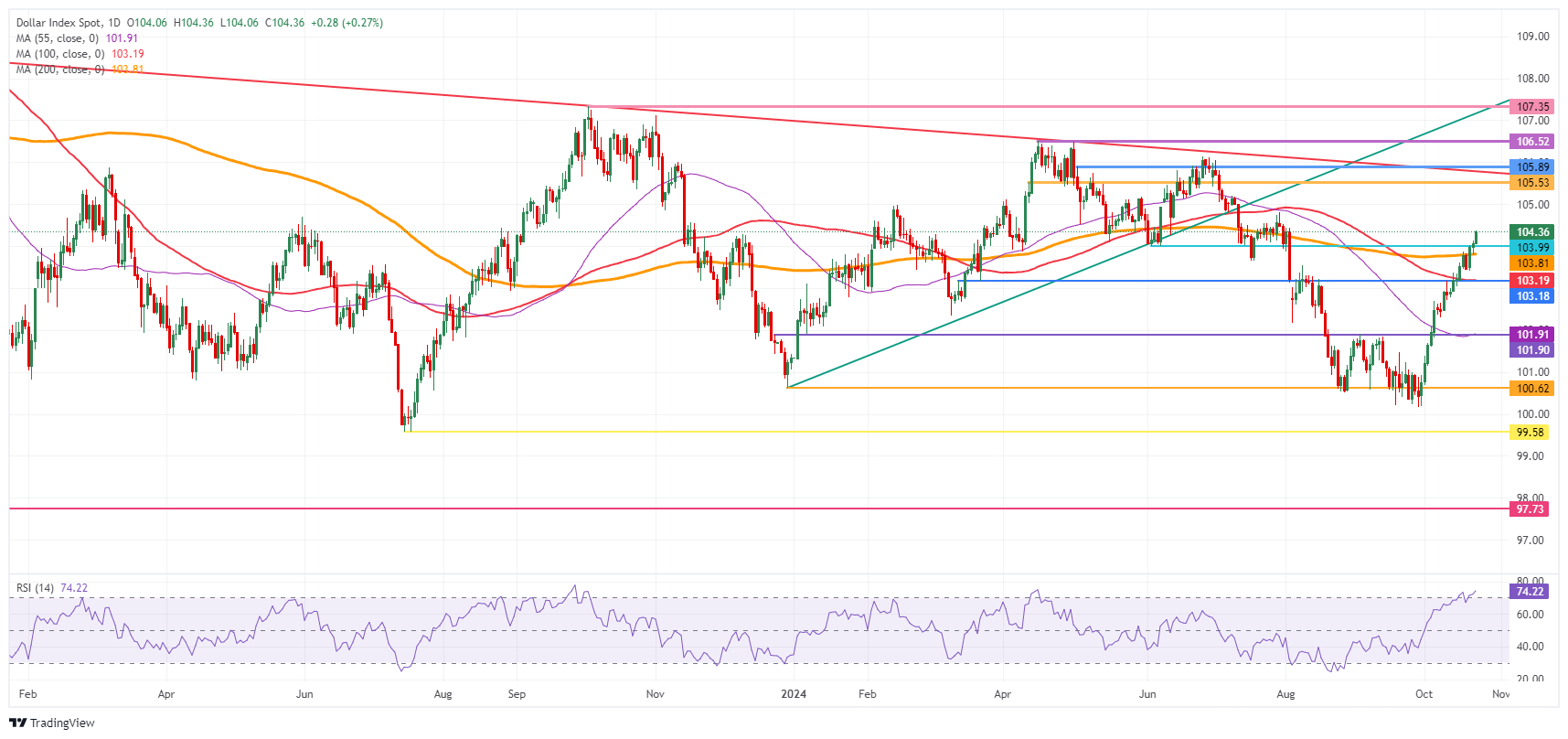- The Dollar stretches further against most of the major G20 currencies.
- US stocks fall further as markets calibrate the new normal for the Fed’s interest rate outlook.
- The US Dollar Index begins its October rally and enters a crucial technical zone.
The US Dollar (USD) strengthens further on Wednesday, driven by uncertainty ahead of the US presidential election and safe haven entry after stocks extended their negative performance. Meanwhile, US bonds continue to sell off, meaning US rates are rising with the benchmark 10-year yield having risen from 4.07% on Monday to 4.23% on Wednesday. The Dollar King is back on the scene and could even accelerate further as uncertainty increases ahead of the November 5 election.
On the US economic front, a very light calendar is ahead for markets to digest on Wednesday. Other than existing home sales numbers, there’s really nothing from an economic data standpoint that would alter the current stance. Instead, look at US earnings where heavyweights like Tesla, IBM, Boeing and Coca Cola are expected to release earnings.
Daily Market Drivers Summary: Focus shifts to stocks and risk
- At 11:00 GMT, the Mortgage Bankers Association (MBA) will publish weekly Mortgage Applications for the week ending 18 October. The number has been contracting for three consecutive weeks. There is no consensus view available, with a 17% contraction in the previous week.
- At 13:00 GMT, Federal Reserve Governor Michelle Bowman will give a keynote address at the Eighth Annual Fintech Conference hosted by the Federal Reserve Bank of Philadelphia.
- At 14:00 GMT, Existing Home Sales for September will be released, with expectations of an increase to 3.9 million units from 3.86 million units in August.
- At 16:00 GMT, Federal Reserve Bank of Richmond President Thomas Barkin will speak about community colleges at the 2024 Virginia Education and Workforce Conference.
- China’s indices are the last ones standing in a sea of red in equity markets.
- CME’s Fedwatch tool supports a 25 basis point (bps) rate cut with an 88.9% probability vs. 11.1% probability of no rate cut by the next Fed meeting on November 7 .
- The US benchmark 10-year yield is trading at 4.22% and continues to rise this week.
DXY Dollar Index Technical Analysis: Buy the Rumor
The US Dollar Index (DXY) is rallying again, set to close October on a very high note in what appears to be a very strong recovery. The Dollar King is returning to the scene with traders finally getting up and starting to position themselves for the US elections on November 5th and the US Federal Reserve rate decision on November 7th. It’s one of the heaviest weeks of this financial year, and the dollar appears to be the place to be ahead of those two events.
The DXY has broken above 104.00 and is now in an empty area that could quickly see 105.00 emerge as the first upside limit. Once above that level, keep an eye on the key levels of 105.53 and 105.89. Ultimately, 106.52 or even 107.35 could show strong resistance and selling pressure with profit taking on the rally materializing at these levels.
On the downside, the 200-day SMA is very strong support due to a test at 103.81. Watch for false breakouts and consider waiting for a daily close below that level when reassessing whether there will be further declines for the DXY. The next major support is twofold, with the 100-day SMA at 103.19 and the key level at 103.18 (March 12 high). If that level is broken, it would lead to a large gap down to the 101.90 support zone, with the 55-day SMA at 101.91.
Dollar Index: Daily Chart
The US Dollar FAQs
The United States Dollar (USD) is the official currency of the United States of America, and the “de facto” currency of a significant number of other countries where it is in circulation alongside local banknotes. According to 2022 data, it is the most traded currency in the world, with more than 88% of all global currency exchange operations, equivalent to an average of $6.6 trillion in daily transactions. After World War II, the USD took over from the pound sterling as the world’s reserve currency.
The single most important factor influencing the value of the US Dollar is monetary policy, which is determined by the Federal Reserve (Fed). The Fed has two mandates: achieve price stability (control inflation) and promote full employment. Your main tool to achieve these two objectives is to adjust interest rates. When prices rise too quickly and inflation exceeds the 2% target set by the Fed, the Fed raises rates, which favors the price of the dollar. When Inflation falls below 2% or the unemployment rate is too high, the Fed can lower interest rates, which weighs on the Dollar.
In extreme situations, the Federal Reserve can also print more dollars and enact quantitative easing (QE). QE is the process by which the Fed substantially increases the flow of credit into a clogged financial system. This is an unconventional policy measure used when credit has dried up because banks do not lend to each other (for fear of counterparty default). It is a last resort when a simple lowering of interest rates is unlikely to achieve the necessary result. It was the Fed’s weapon of choice to combat the credit crunch that occurred during the Great Financial Crisis of 2008. It involves the Fed printing more dollars and using them to buy US government bonds, primarily from financial institutions. QE usually leads to a weakening of the US Dollar.
Quantitative tightening (QT) is the reverse process by which the Federal Reserve stops purchasing bonds from financial institutions and does not reinvest the principal of maturing portfolio securities in new purchases. It is usually positive for the US dollar.
Source: Fx Street
I am Joshua Winder, a senior-level journalist and editor at World Stock Market. I specialize in covering news related to the stock market and economic trends. With more than 8 years of experience in this field, I have become an expert in financial reporting.








